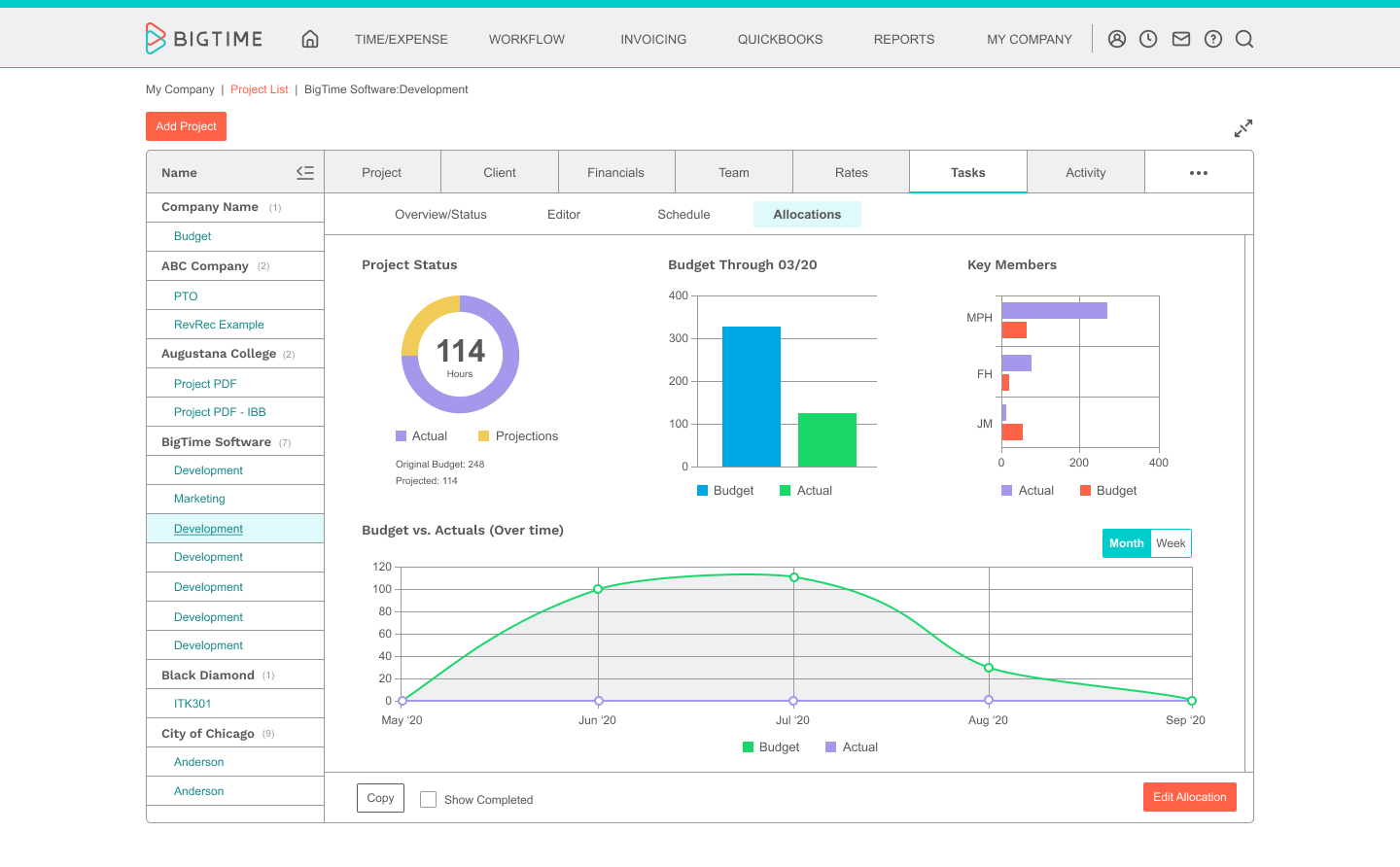Project Profitability Report
Make rapid and insightful decisions regarding a project's budget and allocated staff using a project profitability report.
SHOW ME HOW
Track smarter, not harder
Easily log time and expenses with personalized data entry options for your team's individual timesheets.
Bill fast and friendly
Quickly pull together professional-looking custom invoices and send to your clients without the hassle.
Avoid over/under scheduling
Always have an idea of you who working on what and reduce overall time on the bench.
Keep projects moving
Smoothly handoff work between teams and approval levels with custom workflows so you can manage your projects you way.
Plan ahead and on the fly
See your plans and analyze progress at a glance with dashboards, analytics, and reporting.
Connect your favorite tools
Seamlessly sync your current software with our deep integrations and full tech support from our team.
Better growth starts here.
LEARN MORE
In the professional services industry, organizations develop knowledge instead of creating a tangible product and selling it, and the product they sell is time and expertise. Companies that sell products go through a process to evaluate whether the materials and time going into a product will result in a return on investment where the price of selling the product is more than the cost of what they put into it. While it may seem that this only applies to businesses that sell products, professional services firms should follow the same process if they intend to grow their organization. This evaluation of time and materials versus the cost of the product or service is called a project profitability report.
Evaluating project profitability is the same as an appraisal of projects that a professional services organization intends to take on. In essence, it is the analysis of whether a given project’s revenue will outweigh its costs. The exact aspects of project appraisal may vary slightly, but every project profitability report will contain three key pieces of information–the cost, revenue, and income of the project. It can be beneficial to look at a project appraisal example to understand the concept better. Assume that a professional services firm is considering a project that will cost $5,000 in expenses. This company wishes to evaluate whether that project will be profitable, so they analyze the revenue the project will generate, and it comes to $7,000. To finish the analysis, they subtract the costs from the revenue, and this results in $2,000 in profit. The members of the firm can now see that the project is profitable and worth their time.
The scope of project appraisal reports will look different depending on the size and complexity of the project. For instance, project appraisal in project management for a small firm will be far simpler than a company-wide project that needs to be analyzed for profitability over time and at multiple levels of the organization. While project profitability reports may look simple at first, they require a great deal of information and analysis that can potentially change the trajectory of the firm. Professional services firms must report on project profitability to ensure that their organization is profitable and on the right track to boost growth. BigTime is a software solution for professional services firms that can be used to generate profitability reports automatically to save them time and money.
Project Profitability Report Template
A project profitability report template can be a great place to start when trying to create a report for a specific project. Whether the firm intends to create the report from scratch or a template, it is necessary to ensure that it will contain all of the required information and data. Finding a product profitability analysis template online can be done, but it may need to be edited and reformatted to fit the precise needs of the project and firm. With many organizations relying on Microsoft Excel for their business spreadsheets, a project profitability analysis Excel template might be a good choice.
There are numerous options for a profitability model Excel template. The issue with these templates is that they may not be helpful for determining the costs of the project if the firm does not already have that data. This is where a project cost template Excel spreadsheet might be necessary for the profitability report. Essentially, for research, project budget template Excel sheets would be used to calculate the individual costs in order to determine the total cost of the entire project before comparing that to the revenue to get the profitability. Otherwise, a firm could use a project budget template Word document to perform this research into costs rather than an Excel sheet. The choice of a template and whether it is in Word or Excel will depend on the firm's requirements. BigTime is a software that can be used instead of these templates that makes generating project profitability reports easy and fast with little manual effort.
Project Profitability Analysis
Making money is merely a matter of analysis. Project profitability analysis is the process of determining whether a specific project will be, is, or is not going to make the firm money. All professional services firms want to grow and be more profitable, which is why it is essential to perform an analysis and create a project profitability report. Excel is one of the products that can be used to execute this step in an evaluation. Additionally, because of the capability for formulas, calculating the project’s profitability can be easier with Excel than doing it manually. A project profitability Excel spreadsheet will also be editable so that the firm can update the sheet with new data over time. This is important because profitability should be analyzed before and during a project.
Looking at a profitability model Excel sheet can be a simple way to understand how profitability can be analyzed. At a basic level, it is about researching the total cost of the project in every detail and comparing it to the revenue the project generates. The template for this will be different from a company analysis Excel template or a pricing analysis Excel sheet. The former is for evaluating the profitability of the entire company, and the latter is for analyzing the best price to sell a product at. A product profitability analysis template may work for projects, but it was not designed with projects in mind. The BigTime software was designed for the projects that professional services firms complete and can help them track their costs, revenue, and profit in a centralized platform.
Profitability Index Calculator
How can the profitability of a business be determined? The answer is simple–it depends on the profitability of each project. This is why analyzing profitability is essential for every project. While a professional services firm may have profitable project ideas, if the profitability is not analyzed or calculated, they will not know if the project is viable until it has been started. To analyze profitability, firms can use a project profitability formula or a project profitability analysis Excel template. Whichever tool is used will determine the project profitability report format.
One of the simplest ways to calculate profitability is with the project profitability index formula. This formula is as follows: PI (Profitability Index) = PV (Purchase Value) of future cash flows / initial investment. A profitability index calculator can be a helpful tool to speed up the calculation. For firms that do not want to have to calculate this, BigTime is a software that can do it automatically and produce an accurate measurement of profitability for any project at any time.
Project Profitability Calculator
While firms could calculate profitability manually, it will be faster to use a project profitability calculator. The right calculator will be a profitability index calculator with cost of capital included. This kind of calculator will be very different from an IRR calculator or an NPV calculator. IRR measures the rate of return of an investment, while NPV is for measuring the net present value of an investment. Neither of these will work for calculating profitability. Instead, it is best to ensure that the calculator that will be used is made of the project profitability index formula discussed above.
It is also possible to use Excel as a calculator. A profitability index calculator Excel spreadsheet will have the formula entered into the sheet, but the cells can still be edited depending on the exact needs of the business. If using Excel, the project profitability report format can be in Excel also for ease of use. Otherwise, professional services firms can use BigTime to calculate a project’s profitability automatically.
Project Profitability Report QuickBooks Online
A project profitability analysis Excel template is one way to generate a project profitability report. QuickBooks Online can also be used to analyze profitability and create reports, but it does require integration with Projects. How does QuickBooks Online Payroll integrate with Projects? In a company’s QuickBooks Advanced or Plus account, the Projects feature can be turned on in the Advanced tab under Account and Settings. To track project profitability, QuickBooks requires that the business creates a new project and records costs and revenue. The way that QuickBooks keeps track of projects is through project codes. In QuickBooks, these codes are unique for each project and provide a way to group different entries together for a single project. Among the default project reports QuickBooks allows users to generate are a Project Profitability report, Unbilled Time and Expenses, and Nonbillable Time. QuickBooks can be a helpful tool for analyzing project profitability, but a platform like BigTime that can provide detailed, real-time metrics on profitability for each project and the team that works on it is far more valuable.
Profitability Analysis Example
Understanding profitability analysis can be easier after looking at a profitability analysis example. There are a few things that can affect an example, however, such as the profitability analysis formula that is used. It is also important to know the different types of profitability analysis, including gross profit margin, operating profit margin, return on assets, return on equity, and more. Additionally, a market profitability analysis example will be better if the firm needs to evaluate how to perform a market-wide analysis. On the other hand, if the company is selling a product, then a product profitability analysis example will be more appropriate. When performing a profitability analysis of a company, either a market, product, or project profitability example will help with understanding how to do the analysis, but a wider scale example might be more helpful.
A simple profitability analysis example could look like this: a professional services firm begins work on a project, and they perform calculations and research until they know that the project will cost them $10,000. The analysis continues as the firm understands it will generate $15,000 in revenue. With these two pieces of data, the firm calculates the difference and can now see that the project will generate $5,000 in income. While most projects will be more complex, this example may help to illustrate how profitability analysis works. For professional services firms that want to grow, BigTime is a software that can perform profitability analysis automatically to get businesses the data they need to succeed.



